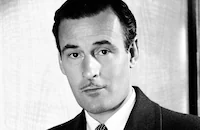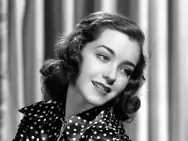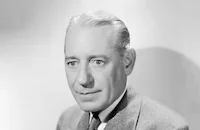The Trial of Mary Dugan
Cast & Crew
Norman Z. Mcleod
Robert Young
Laraine Day
Tom Conway
Frieda Inescourt
John Litel
Film Details
Technical Specs

Synopsis
On the day that she is to be released after an eighteen-month sentence at a reformatory, model inmate Mary Dugan throws a bottle of ink at one of her teachers, Miss Edith Matthews, and is given a six-month extension. Mary, who stole $500 to help her father, John Dugan, out of trouble, is shattered that she cannot leave to join him in Los Angeles and wants to run away. Her friend, Agatha Hall, who is also scheduled for release, at first tries to talk her out of it, but later advises her to change her name and stay out of trouble. When Mary reaches Los Angeles, she telephones Dugan and arranges a meeting, but when he sees her, he rushes across the street and is hit by a car. After Dugan dies of his injuries, Mary, who has assumed the name "Mary Andrews," asks businessman Edgar Wayne, the owner of the chauffeur-driven car involved in the accident, for a job as a stenographer. Wayne agrees, and soon Mary's hard work has advanced her through the company to the position of Wayne's private secretary. During this time, Jimmie Blake, an attorney for the company, begins to see Mary and the two fall in love. One day, Aggie, who is now a show girl using the name "Irene DaRue," comes to see Mary. Mary is happy to see her, but is concerned that she so easily located her through Dugan's former address. A short time later, Mary learns from John Masters in personnel that Wayne has raised her pay to $60 a week, an unprecedented salary for a secretary. That same night, Jimmie proposes to her and says that they must leave shortly for a new, higher paying job he has just gotten in Chile. Mary is very happy to accept, but when she learns that she must get a passport and cannot get one without a birth certificate, she realizes that her true identity will come out and is afraid that she will be sent back to the reformatory. When she suddenly tells Jimmie that she cannot marry him, he leaves, thinking that she simply cares too much for her boss. A few weeks later, Wayne, concerned over Mary's obvious unhappiness, guesses the cause and reveals that he has known her true identity for months. He then tells her that shortly after she came to work, the authorities discovered her whereabouts and came to him. Because of his confidence in her and his persuasiveness, he convinved them to let him keep an eye on her. Mary is touched by his gesture and calls him the kindest man in the world. A year later, Jimmie returns to Los Angeles and immediately reads a front page photo story about the trial of "Mary Dugan," who is accused of having murdered Wayne. Jimmie goes to the courthouse and hears damning testimony from several witnesses. Aggie stands up for Mary, but Miss Matthews testifies to Mary's bottle-throwing "rage," and Masters testifies that at the time of Wayne's death, Mary's salary had risen to the extraordinary sum of $150 per week. After court, Jimmie goes to Mary's plush apartment, talks with her landlady, Mrs. Collins, and reviews some of the evidence in the case. When the trial resumes, Mrs. Wayne takes the stand and says that Wayne had been having an affair with Mary but had just told his wife that he wanted to end the affair. Mrs. Wayne also says that Wayne feared that Mary, who had threatened him before, would kill him if he ever tried to break off their relationship. When Mary's attorney, Mr. West, does not cross-examine the widow, Jimmie is shocked and goes to Mary, who had not seen him earlier in the courtroom. He convinces her to let him take her case, and West, who lives in the same building as Mary, withdraws. The next day, Mary testifies on her own behalf, revealing that she and Wayne had become very close but were not having an affair. Wayne came to her apartment that night because he had caught his wife with another man and, as he was planning to get a divorce, could reveal his feelings of love for Mary. Because he wanted to go out, she went to wash her face and hands in the bathroom. When she returned, she found Wayne's body, stabbed and covered with blood. After Mary ends her testimony, Jimmie recalls Mrs. Wayne to the stand and asks her to repeat her testimony from the previous day. As she is testifying, Jimmie follows along in the court transcript and sees that her testimony is word-for-word what it had been. He then reveals this information to the court and requests that she be charged with perjury. Before she leaves the stand, Jimmie asks her to sign her name and is surprised that she is right-handed, because he had earlier proven that the murderer had to have been left-handed. Now Mrs. Collins takes the stand and her testimony shows that Mary's apartment was furnished with only one knife like the murder weapon and that knife was still in Mary's kitchen. Jimmie then calls West and confronts him with the fact that he had borrowed Mrs. Collins' passkey on the night of the murder and could therefore have unlocked and relocked Mary's apartment. Jimmie accuses West of being "the other man" in Mrs. Wayne's life, then tosses the knife at him. West reveals himself to be the real killer when he automatically catches the knife with his left hand. Finally, after Mary and Jimmie are married, Jimmie opens his own criminal law office to help other people who are in trouble.

Director

Norman Z. Mcleod
Cast

Robert Young

Laraine Day

Tom Conway

Frieda Inescourt

John Litel

Marsha Hunt

Henry O'neill

Marjorie Main

Sara Haden
Francis Pierlot

Addison Richards

Pierre Watkins
Alma Kruger
George Watts

Ian Wolfe
Cliff Danielson
Cliff Clark
Milton Kibbee
Nora Perry
Minerva Urecal
Paul Porcasi
Larry Wheat
Walter Lawrence
Matt Moore
Anna Q. Nilsson
William Tannen
Kay Sutton

Joe Yule

Joan Barclay
Hal Cooke
William Stelling
Jessie Arnold
Betty Farrington
Ernie Alexander
Crew
George Boemler
Howard Campbell
George Folsey
Cedric Gibbons
Sydney Guilaroff
Edwin Knopf
Oliver T. Marsh
Douglas Shearer
Marvin Stuart
Dolly Tree
Edwin B. Willis

Film Details
Technical Specs

Quotes
Trivia
Notes
One post-production Hollywood Reporter news item referred to this film as The Crime of Mary Andrews, which May briefly have been considered as a release title. The film's opening credits read "Based on the play by Bayard Veiller," and do not assign screenplay credit. According to a June 9, 1941 memo contained in the AMPAS library file on the film, producer Edwin Knopf "has taken the play by Bayard Veiller, and with very few changes, produced the play [as a film]." According to Hollywood Reporter news items, May McAvoy was to have a small part in the film along with "twenty other prominent actors and actresses" from the silent era. Although several former silent stars, including Anna Q. Nilsson and Matt Moore, were in the film, McAvoy's appearance in the released film has not been confirmed. Early Hollywood Reporter production charts list Oliver T. Marsh as the cameraman, but the film only credits George Folsey.
Veiller's play was previously filmed by M-G-M in 1929. That film was directed and written by Veiller himself, and starred Norma Shearer and Lewis Stone. In 1931, M-G-M made a Spanish-language version entitled El proceso de Mary Dugan, directed by Marcel De Sano, and starring María Ladrón de Guevara and José Crespo. That same year, De Sano directed a French-language version of the film, Le procès de Mary Dugan, starring Huguette ex-Duflos, and Arthur Robison directed a German-language version, Mordprozess Mary Dugan, starring Nora Gregor.












